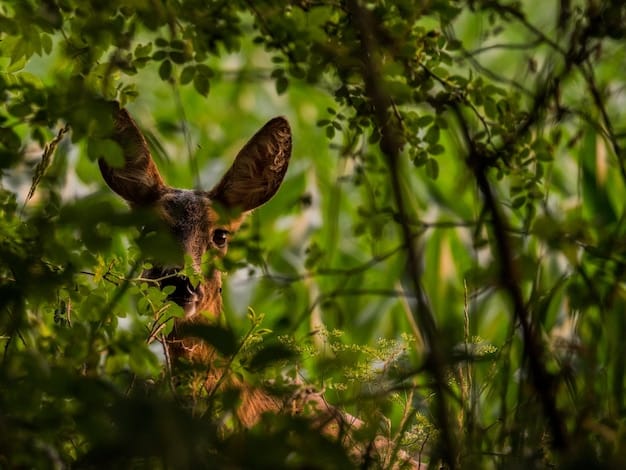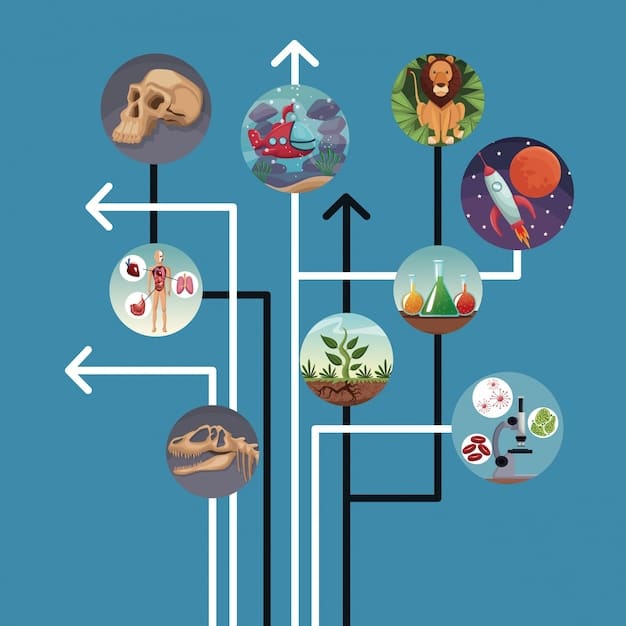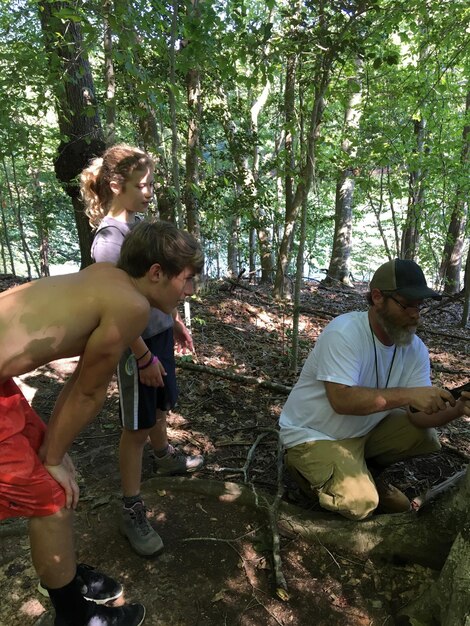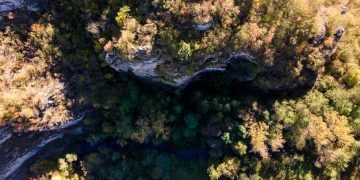Endangered Species Act in 2025: Impacts on Wildlife Conservation

The updated Endangered Species Act in 2025 is poised to significantly influence wildlife conservation efforts by refining protection measures, addressing emerging threats, and promoting collaborative conservation strategies to safeguard vulnerable species and their habitats.
The Endangered Species Act (ESA) has been a cornerstone of wildlife conservation in the United States for decades. As we look ahead to 2025, anticipated updates to the ESA promise to reshape conservation efforts. Understanding how will the updated Endangered Species Act impact wildlife conservation efforts in 2025? is crucial for conservationists, policymakers, and anyone interested in protecting biodiversity.
The Endangered Species Act: A Brief Overview
The Endangered Species Act, enacted in 1973, provides a framework for protecting endangered and threatened species and their habitats. Its primary goal is to prevent extinction and promote the recovery of listed species. Understanding the ESA’s core components is essential for grasping the significance of upcoming updates.
Key Provisions of the ESA
The ESA operates through several key provisions that work together to safeguard vulnerable species.
- Listing Species: The process of identifying and officially listing species as either endangered or threatened based on scientific data regarding their risk of extinction.
- Critical Habitat Designation: Identifying and protecting specific geographic areas essential for the conservation of listed species.
- Recovery Plans: Developing and implementing plans outlining actions necessary to help listed species recover and thrive.
- Prohibitions: Restrictions on activities that could harm or harass listed species, along with exceptions for scientific research and other permitted activities.
These provisions form the bedrock of the ESA, guiding conservation efforts across the country.
Historical Impact of the ESA
The ESA has a proven track record of preventing extinctions and aiding in the recovery of numerous species. Notable success stories include the bald eagle, the gray wolf, and the American alligator, all of which have been downlisted or delisted thanks to ESA protections. The act has not only saved species from the brink but has also contributed to habitat preservation and ecosystem health.
The ESA’s impacts extend beyond individual species, fostering broader awareness and support for conservation initiatives. As the ESA continues to evolve, its historical impact provides valuable lessons and perspectives for future conservation efforts.
Anticipated Updates to the ESA in 2025
As we approach 2025, several anticipated updates to the Endangered Species Act are expected to enhance its effectiveness and address contemporary conservation challenges. These updates may encompass revisions to listing processes, habitat protection measures, and collaborative strategies.

Possible Revisions to Listing Processes
One potential area for updates revolves around the process of listing species under the ESA. Streamlining the listing process and incorporating advanced scientific data could expedite protection for species facing imminent threats. Some possible revisions include:
- Expedited Reviews: Implementing faster review processes for species facing critical threats, ensuring timely protection.
- Incorporating Climate Change Data: Using climate change models and data to predict future threats and prioritize species at risk.
- Standardizing Data Collection: Establishing standardized protocols for data collection and analysis to ensure consistency and accuracy in listing decisions.
These revisions could make the listing process more efficient and responsive to emerging conservation needs.
Enhancements to Habitat Protection Measures
Habitat protection is a cornerstone of the ESA, and updates in this area could significantly impact conservation outcomes. Enhancements to habitat protection measures might include:
- Expanding Critical Habitat Designations: Identifying and protecting additional areas essential for the survival and recovery of listed species.
- Implementing Habitat Connectivity Strategies: Creating corridors and pathways to connect fragmented habitats, allowing for greater species movement and genetic exchange.
- Incentivizing Private Land Conservation: Offering incentives to private landowners to manage their land in ways that benefit listed species and their habitats.
Such enhancements could bolster the ESA’s ability to protect vital habitats and promote biodiversity.
The anticipated updates to the ESA in 2025 reflect an ongoing effort to refine and strengthen the act’s ability to safeguard endangered and threatened species in the face of evolving conservation challenges. By addressing listing processes and habitat protection measures, these revisions aim to enhance the overall effectiveness of wildlife conservation efforts.
How These Updates Will Affect Conservation Strategies
The anticipated updates to the Endangered Species Act in 2025 are expected to have far-reaching effects on wildlife conservation strategies. These changes could influence how conservationists prioritize their efforts, collaborate with stakeholders, and implement recovery plans.

Shifting Priorities in Conservation Efforts
With updated guidelines and criteria, conservation efforts may shift to focus on species and ecosystems facing the greatest threats. This could lead to a redistribution of resources and attention to areas where conservation interventions are most needed. Potential shifts include:
- Focus on Climate-Vulnerable Species: Prioritizing species and habitats most vulnerable to climate change impacts, such as sea-level rise, altered precipitation patterns, and extreme weather events.
- Ecosystem-Based Conservation: Adopting a broader ecosystem-based approach to conservation, recognizing the interconnectedness of species and their habitats.
- Preventative Conservation: Placing greater emphasis on preventative conservation measures to prevent species from declining to the point where they require listing under the ESA.
These shifts could result in more proactive and effective conservation strategies.
Increased Collaboration and Stakeholder Engagement
Effective conservation requires collaboration among various stakeholders, including government agencies, non-profit organizations, private landowners, and local communities. Updates to the ESA could foster greater collaboration through:
- Incentivizing Partnerships: Providing incentives for collaborative conservation projects that involve multiple stakeholders.
- Promoting Community-Based Conservation: Empowering local communities to play a greater role in conservation efforts through education, training, and resource sharing.
- Enhancing Communication and Transparency: Improving communication and transparency in ESA processes to build trust and foster greater stakeholder engagement.
By promoting greater collaboration, the updated ESA could lead to more sustainable and effective conservation outcomes.
The anticipated updates to the ESA in 2025 are poised to significantly influence wildlife conservation strategies, leading to shifts in priorities and increased collaboration among stakeholders. By adapting to these changes, conservationists can enhance their ability to protect endangered and threatened species and their habitats.
The Role of Technology in Enhanced Conservation
Advancements in technology are increasingly playing a crucial role in enhancing wildlife conservation efforts. As we look towards 2025, these technologies are poised to become even more integral to monitoring, research, and conservation management. Integrating modern tools can vastly improve the efficiency and effectiveness of conservation strategies.
Advanced Monitoring Techniques
Technology offers several advanced monitoring techniques that provide real-time data on species populations, behavior, and habitat conditions. These techniques include:
- Remote Sensing: Using satellite imagery and drone technology to monitor habitat changes, track wildlife movements, and detect illegal activities such as poaching.
- Acoustic Monitoring: Deploying acoustic sensors to record animal sounds, allowing researchers to monitor species presence, abundance, and behavior in remote or inaccessible areas.
- DNA Barcoding: Utilizing DNA barcoding techniques to identify species from environmental samples, such as water or soil, providing valuable insights into biodiversity and ecosystem health.
These technologies allow for more comprehensive and accurate monitoring of wildlife populations and their habitats.
Data Analysis and Predictive Modeling
The vast amounts of data generated by modern monitoring techniques require sophisticated tools for analysis and interpretation. Data analysis and predictive modeling can provide valuable insights into:
- Population Trends: Analyzing long-term data sets to identify trends in species populations, assess the effectiveness of conservation interventions, and predict future population trajectories.
- Habitat Suitability: Modeling habitat suitability based on environmental variables such as climate, vegetation, and topography to identify areas that are most critical for species survival.
- Risk Assessment: Assessing the risks posed by various threats, such as habitat loss, climate change, and invasive species, to prioritize conservation efforts and develop targeted management strategies.
These analytical tools can help conservationists make more informed decisions and allocate resources more effectively.
The incorporation of technology into wildlife conservation efforts is revolutionizing our ability to monitor, understand, and protect endangered and threatened species. As we look towards 2025, these technologies are expected to play an increasingly important role in enhancing conservation outcomes.
Addressing Challenges and Potential Pitfalls
While the anticipated updates to the Endangered Species Act in 2025 hold great promise for enhancing wildlife conservation efforts, it is essential to acknowledge and address potential challenges and pitfalls. Recognizing these obstacles allows for proactive planning and mitigation strategies.
Funding Constraints and Resource Allocation
One of the most significant challenges facing wildlife conservation is funding constraints and the allocation of resources. Limited financial resources can hinder the implementation of conservation strategies, including habitat protection, species recovery, and monitoring efforts.
- Insufficient Funding: Many conservation projects are underfunded, limiting their scope and effectiveness.
- Competing Priorities: Conservation efforts must compete with other societal priorities for funding, such as healthcare, education, and infrastructure.
- Uneven Resource Allocation: Resources may be unevenly distributed among species and regions, with some species receiving greater attention and funding than others.
Addressing these funding constraints requires creative financing mechanisms and strategic resource allocation.
Political and Social Opposition
Wildlife conservation can sometimes face political and social opposition from various stakeholders, including private landowners, industries, and political groups. This opposition can manifest as:
- Resistance to Regulations: Landowners and industries may resist regulations that restrict their activities in order to protect endangered species and their habitats.
- Conflicting Economic Interests: Conservation efforts may conflict with economic interests, such as logging, mining, and development.
- Lack of Public Support: Widespread public support is essential for successful conservation, but apathy or opposition from certain segments of society can undermine conservation efforts.
Overcoming political and social opposition requires effective communication, stakeholder engagement, and the development of mutually beneficial solutions.
The anticipated updates to the Endangered Species Act in 2025 offer significant opportunities for enhancing wildlife conservation, but addressing these challenges and potential pitfalls is crucial for ensuring the long-term success of conservation efforts. Proactive planning, adaptive management, and collaborative approaches are essential for navigating these obstacles and achieving conservation goals.
The Future of Wildlife Conservation Beyond 2025
Looking beyond 2025, the future of wildlife conservation will likely be shaped by several emerging trends and challenges. Adapting to these changes and embracing innovative approaches will be essential for ensuring the long-term survival of endangered and threatened species.
Climate Change Adaptation Strategies
Climate change is already having profound impacts on wildlife and their habitats, and these impacts are expected to intensify in the coming years. Conservation strategies must incorporate climate change adaptation measures, such as:
- Habitat Restoration: Restoring degraded habitats to increase their resilience to climate change impacts, such as drought, flooding, and extreme weather events.
- Assisted Migration: Translocating species to more suitable habitats as their current ranges become uninhabitable due to climate change.
- Genetic Management: Managing genetic diversity to enhance species’ ability to adapt to changing environmental conditions.
These adaptation strategies can help mitigate the impacts of climate change on wildlife populations.
Integrating Human Dimensions into Conservation
Recognizing the interconnectedness of human societies and natural ecosystems is crucial for effective conservation. Integrating human dimensions into conservation involves:
- Community Engagement: Engaging local communities in conservation planning and management to ensure that their needs and perspectives are considered.
- Sustainable Livelihoods: Promoting sustainable livelihoods that support both human well-being and biodiversity conservation.
- Environmental Education: Raising awareness about the value of biodiversity and the importance of conservation among all segments of society.
By integrating human dimensions into conservation, we can create more sustainable and equitable conservation outcomes.
The future of wildlife conservation beyond 2025 will require a holistic and adaptive approach that incorporates climate change adaptation, integrates human dimensions, and embraces innovative technologies. By addressing these challenges and seizing these opportunities, we can create a more sustainable future for both wildlife and people.
| Key Point | Brief Description |
|---|---|
| 🌱 ESA Updates | Anticipated revisions in 2025 could enhance species protection and habitat measures. |
| 🤝 Collaboration | Increased stakeholder engagement is crucial for effective conservation strategies. |
| 💻 Technology | Advanced monitoring and data analysis techniques are vital for conservation. |
| 🌍 Climate Adaptation | Strategies to help species adapt to changing climate conditions are essential. |
FAQ Section
▼
The Endangered Species Act (ESA) is a U.S. law enacted in 1973 to protect critically imperiled species from extinction. It outlines procedures for listing species, designating critical habitats, and implementing recovery plans.
▼
The upcoming updates aim to streamline listing processes by using advanced scientific data, expediting reviews for critically threatened species, and incorporating climate change data for future threat predictions.
▼
Enhancements may include expanding critical habitat designations, implementing habitat connectivity strategies, and incentivizing private land conservation to protect vital species habitats effectively.
▼
Technology enhances conservation through advanced monitoring techniques like remote sensing and acoustic monitoring, aiding in real-time data collection about populations, behaviors, and habitats.
▼
Challenges include funding constraints, resource allocation, political and social opposition from stakeholders, and resistance to regulations that might affect economic interests or land use.
Conclusion
The updated Endangered Species Act in 2025 is poised to usher in a new era of wildlife conservation. By refining protection measures, promoting collaboration, and leveraging technological advancements, the ESA can more effectively safeguard endangered and threatened species for generations to come, ensuring a richer and more biodiverse future.





